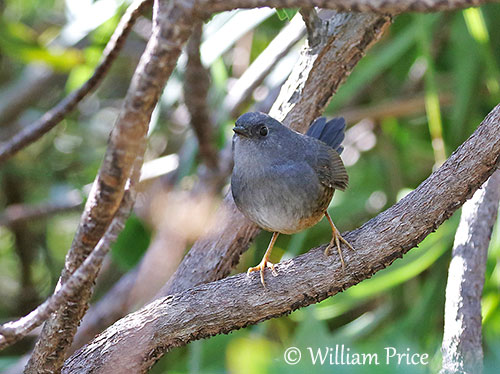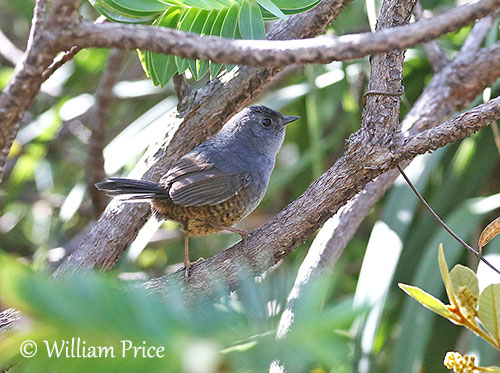
REPRODUCTION OF THIS SPECIES:
The breeding season takes place at least from October to February.
An observation made in Serra do Gandarela National Park, Minas Gerais, Brazil, allows describing the nest.
A nest was discovered inside a ferruginous cave. The closed nest was made of cryptogams (ferns, mosses and lichens), grasses and bird feathers, especially flight-feathers of passerines.
Two white eggs where inside the nest.
In the same site, a new nest was recorded in the next breeding season. The nest-site was reused within, but also between breeding periods.
This observation suggests a strong association between the Rock Tapaculo and the ferruginous caves, meaning that this environment must be preserved as it is threatened by mining activities.
PROTECTION / THREATS / STATUS:
The Rock Tapaculo has restricted range and patchy distribution.
The species is threatened by loss and degradation of the habitat in some parts of the range.
It persists in partially deforested and burnt areas with invasive plants. It is present in several protected areas and national parks.
The size of the population is unknown, but it is suspected to be decreasing. However, the species is not considered globally threatened
The Rock Tapaculo is currently evaluated as Least Concern.
Fr: Mérulaxe des rochers - Mérulaxe pétrophile
Ang: Rock Tapaculo
All: Felstapaculo
Esp: Churrín Roquero
Nd: Rotstapaculo
Sd: klipptapakul
Photographer:
William Price
PBase-tereksandpiper & Flickr William Price
Text by Nicole Bouglouan
Sources:
HANDBOOK OF THE BIRDS OF THE WORLD Vol 8 By Josep del Hoyo-Andrew Elliott-David Christie - Lynx Edicions - ISBN: 8487334504
BIRDS OF SOUTH AMERICA – Passerines - by Robert S. Ridgely and Guy Tudor – HELM Field Guides – ISBN: 9781408113424
First description of the nesting site, nest, and eggs of the Rock Tapaculo (Scytalopus petrophilus)
Fatbirder - The World’s Richest Information Resource about Birds for Birders
Endemic Brazilian tapaculos, with a brief résumé of their current taxonomy
Arthur Grosset's Birds (Arthur Grosset)
Wikipedia, the free encyclopaedia
Wikipedia, la enciclopedia libre
Rock Tapaculo
Scytalopus petrophilus
Passeriformes Order – Rhinocryptidae Family
INTRODUCTION:
The tapaculos are described as « the mice of the avian world ». They usually have cryptic plumage and are very small birds. To find them among the dense undergrowth where they forage is always a great pleasure.
The members of the genus Scytalopus are found in forest understorey or among tussocks and rocky boulders. They are poor fliers, sedentary and with skulking habits.
The taxonomy of this genus is complex with seven species recently described (more are coming). Identification to species level is generally made on the basis of range, elevation and primary song.
The Rock Tapaculo is found in SE Brazil. It is among the recently described species and the latest of these announced discoveries.
It is endemic to the southern Espinhaço Mountains and other locations in Minas Gerais where it frequents the forested areas at high elevations. It feeds on insects and arthropods found in the leaf litter, and forages on the ground.
The breeding behaviour is poorly known, although some observations give us interesting information. This species nests in a covered location such as burrow, tree hole or domed nest.
The Rock Tapaculo has restricted range and patchy distribution. It is threatened by habitat loss and degradation in some parts of the small range.
DESCRIPTION OF THE BIRD:
Biometrics:
Length: 10-11 cm
Weight: 11-16 g
The Rock Tapaculo has grey plumage almost overall. The upperparts including upperwing and tail are dark grey. The uppertail-coverts are brownish-yellow with black barring.
The underparts are grey, but the belly is whitish with variable amount of pale grey. Flanks, thighs and undertail-coverts are brownish-yellow with black bars.
On the head, the crown is dark grey. Lores, ear-coverts, chin and throat are grey.
The bill is black with paler tip. The eyes are dark brown. Legs and feet are brownish-flesh.

The female resembles male but she is browner.
The juvenile shows variable amount of dark barred brownish feathers.
RANGE:
The Rock Tapaculo is found in C and S of Espinhaço Mountains, between 900 and 2,100 metres of elevation, and also in Mantiqueira Mountains of Minas Gerais in Brazil. But the species can be seen in adjacent regions such as N Sao Paulo, and near the border with Rio de Janeiro in E Brazil.
HABITAT:
The Rock Tapaculo is found in a variety of habitats, from open scrub and grass formations in high rocky areas, to forested patches on hills.
In Espinhaço Mountains, it can be seen in rugged areas and rock fields with low trees, shrubs and grasslands.
But the species also persists in partially deforested and burnt areas in mountains, where invasive plants such as the ferns Pteridium aquilinum are growing, providing the birds a dense cover.
CALLS AND SONGS: SOUNDS BY XENO-CANTO
The Rock Tapaculo has several types of vocalizations, showing great similarity with two other species of the same genus, S. pachecoi and S. diamantinensis.
The contact call is a strong “pzeen” note, shorter and more downslurred than the call of those two species.
The song is a long, rapid succession of “tchiip” notes. It may last more than a minute.
BEHAVIOUR IN THE WILD:
The Rock Tapaculo feeds on insects and various small arthropods, by picking and probing into the leaf litter. Small seeds and soft plant material are probably eaten too.
It forages mainly on the ground, scratching with the feet, hopping slowly or more quickly over rocks and crevices among the dense vegetation. The members of genus Scytalopus glean prey from moss, earth and rotting vegetation while moving along quickly on the ground and in the undergrowth. While foraging in this way, they appear very mouse-like.
The breeding behaviour is poorly known. The male sings more frequently during the breeding season. It often sings while perched on a stone, hidden by the vegetation, but also from low perches within the forest.
It sings usually after sunrise, and occasionally during the rest of the day if the sky is cloudy. However, on clear days, it sings again in the evening.
The Rock Tapaculo nests in a covered location such as burrow or tree hole, or in a domed nests. The nest-site is also reused between reproductive seasons.
The Rock Tapaculo is sedentary.
Like other tapaculos, it is very reluctant to cross open areas or to fly. It is mainly terrestrial and flies poorly on its short wings. But legs and feet are strong.
